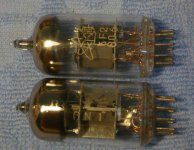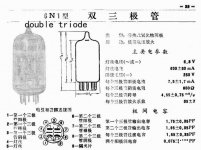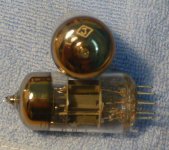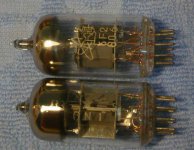6n1p has a shield between triodes , pin 9 , usually grounded.
12AU7 , ECC81 , 82 , 83 etc uses pin9 for filament connection. So , it's not wise to put an 12AU7 in your amplifier , it could blow up
ECC88 is a good option .
12AU7 , ECC81 , 82 , 83 etc uses pin9 for filament connection. So , it's not wise to put an 12AU7 in your amplifier , it could blow up

ECC88 is a good option .
Cheers and thanks to all for your help...
I've gone a cheap option to swap all the tubes from the 'bottom of the heap' tubes which came with the amp. My goal is simply to hear there is an audible difference to the sound the amp makes, then I'll go on a mission to buy the valves that best suit my ears and musical taste...
Thanks again...
I've gone a cheap option to swap all the tubes from the 'bottom of the heap' tubes which came with the amp. My goal is simply to hear there is an audible difference to the sound the amp makes, then I'll go on a mission to buy the valves that best suit my ears and musical taste...
Thanks again...

Wavebourne: Do the Chinese "always" drop the fourth figure?
I've seen a 6N6 in some schematics - guess it's a 6N6P, but who knows for sure.😕
I've seen a 6N6 in some schematics - guess it's a 6N6P, but who knows for sure.😕
1 of the 2 6N1 preamp tubes is printed upwards and says 6N1-J, the other downwards and 6N1
Both have the same chinese company brand...
Both have the same chinese company brand...
soundbrigade said:Wavebourne: Do the Chinese "always" drop the fourth figure?
I've seen a 6N6 in some schematics - guess it's a 6N6P, but who knows for sure.😕
As discovered in this article, no: while they usually take Russian tubes and drop P, or take S tubes (octal) and replace S by P, but from this thread we learned that they took EF82 and made 6F2, it is confusing since Russian 6F2P never existed AFAIK, so it would be great to find some Chinese book about their tubes, because they are one of major tube manufacturers nowadays.
fauxpas said:1 of the 2 6N1 preamp tubes is printed upwards and says 6N1-J, the other downwards and 6N1
Both have the same chinese company brand...
...and both have the same internal structure, right?
I may guess, "-J" means slight technological changes for some non-electrical parameters, such as needed to improve stability on high levels of vibrations, or something similar. I suspect that in home equipment they will perform identically.
soundbrigade said:...... and a 6F-tube is a triode/pentode .......
Yes, but in this particular case (6F2) it does not match any Russian tube if to drop off a last "P". It means, we need to find a reliable source of a Chinese tube data. I hope, somebody from China participating on this forum can help to obtain one for the community.
And my confusion as a tube newb is exacerbated by the 'replaceable tube' conundrum. 'This' tube can replace 'that' tube. And if that's the case this tube can replace that tube and on and on and on...
I know that learned folk will know what actually will and will not work, but I'm not learned...
I know that learned folk will know what actually will and will not work, but I'm not learned...

hello fauxpas,
i understand that it can be very confusing sometimes...
especially when you're not 'learned'....
there are a few things to keep in mind....as all (triode) tubes have three major specifications.
mu= amplification factor (how much does the tube amplify)
S = steepness (how much change in drawn current when i change 1 volt on the grid)
Ri= internal resistance
You can find these parameters in the tube's datasheet (google for frank datasheet, you can see almost every tube)
With these you can make a ROUGH indexing if, or not a tube will work (you can also see which pin of he tube is connected to which element)
If you compare two tubes and one of these parameters is way off, you can conclude that it will not work. or at least, will not sound good
easy, eh? well, not really, the second thing that matters is:
how is the tube used, or which setting has one given it.
That depends on how much voltage is on the plate and how much current goes through it (primarily defined by the plate resistor) AND how much volt the grid is negative (determined by the cathode resistor or by a negative supply)
These last factors (operating point) determine they way that mu,s,ri is for real!
If you would like to know more, for yourself, this link might come in handy:
http://boozhoundlabs.com/howto/
If not, keep asking!! (or pm)
best,
Henk
So
i understand that it can be very confusing sometimes...
especially when you're not 'learned'....
there are a few things to keep in mind....as all (triode) tubes have three major specifications.
mu= amplification factor (how much does the tube amplify)
S = steepness (how much change in drawn current when i change 1 volt on the grid)
Ri= internal resistance
You can find these parameters in the tube's datasheet (google for frank datasheet, you can see almost every tube)
With these you can make a ROUGH indexing if, or not a tube will work (you can also see which pin of he tube is connected to which element)
If you compare two tubes and one of these parameters is way off, you can conclude that it will not work. or at least, will not sound good
easy, eh? well, not really, the second thing that matters is:
how is the tube used, or which setting has one given it.
That depends on how much voltage is on the plate and how much current goes through it (primarily defined by the plate resistor) AND how much volt the grid is negative (determined by the cathode resistor or by a negative supply)
These last factors (operating point) determine they way that mu,s,ri is for real!
If you would like to know more, for yourself, this link might come in handy:
http://boozhoundlabs.com/howto/
If not, keep asking!! (or pm)
best,
Henk
So
Cheers, thanks for that...
I am slowly learning... It's taking me a lot to swap my thinking over to electronics after many decades of mechanical thinking...
I am slowly learning... It's taking me a lot to swap my thinking over to electronics after many decades of mechanical thinking...
fauxpas said:Yep, the tube in the bottom of this pic are the exact tubes I have...
I have some 6N1 russian tubes coming to replace them...
Russian tubes are called 6N1P
Wavebourn said:
Russian tubes are called 6N1P
Yep, 6N1P.
I believe the chinese tubes that go into cheap chinese amps must come from a 44 gallon drum of 'tubes that will fit' that socket.
What confused me at the start was that one tube was marked 6N1 (no J or P) and the other was marked 6N1J.
fauxpas said:
Yep, 6N1P.
I believe the chinese tubes that go into cheap chinese amps must come from a 44 gallon drum of 'tubes that will fit' that socket.
What confused me at the start was that one tube was marked 6N1 (no J or P) and the other was marked 6N1J.
As our Chinese comrade explained, "J" means "military QA passed". Another tube did not come through a military QA. I don't think there should be differences for home audio usage, however I have no experience at all with Chinese tubes.
Wavebourn said:As our Chinese comrade explained, "J" means "military QA passed". Another tube did not come through a military QA.
My point is, how did tubes from different sources end up in my amp? I would have expected both tubes to be the same, either 6N1 or 6N1J.
At least the russian tubes are inexpensive... Will be trialling a few...
- Status
- Not open for further replies.
- Home
- Amplifiers
- Tubes / Valves
- 6f2 - 6n1???



